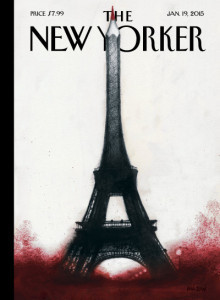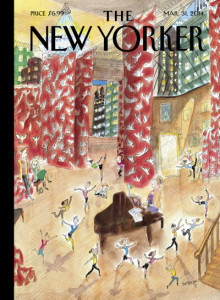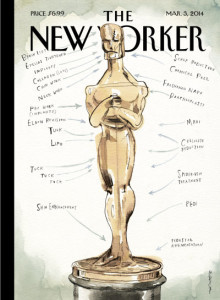Clifford Garstang's Blog, page 55
January 14, 2015
The New Yorker: “Breadman” by J. Robert Lennon
 January 19, 2015: “Breadman” by J. Robert Lennon
January 19, 2015: “Breadman” by J. Robert Lennon
Weird story. I liked it. The first person narrator joins a queue in a small shop to buy bread from the Breadman. He’s there at the behest of his wife, Kathy, who has a standing order and also wants to loaves of the Breadman’s focaccia. It’s a fairly elaborate system. He has to sign in, include his wife’s account number, and preserve his place in line. (It’s reminiscent, I thought, of William Trevor’s “Bullet in the Brain”.) The narrator finds it all mildly amusing, until, while he leaves the line to pour himself some coffee, someone else takes his place. He comforts himself that he’s still at the end of the line, so it doesn’t really matter, but it bothers him anyway. (It would bother me, too, so I was totally relating to his discomfort here.)
No surprise: when they finally get to the front, the guy who has taken his place is greeted by the Breadman—he’s called “Spokefather”—and gets the last two loaves of focaccia. Our narrator goes a little nuts, especially when it turns out the bread is for Spokefather’s old dog. A confrontation and rapid unraveling ensue.
The story has something of an allegorical feel, to it, but what’s the message? Be patient? Don’t lose your place in line? Don’t get upset if you DO lose your place in line? The focaccia’s not really worth it?
You might want to skip the Q&A with J. Robert Lennon if only because it reveals that the story isn’t really about anything. (Oh, he says it’s something about the mores of small communities, but that’s kind of vague.)
January 12, 2015
The New Yorker: “A Sheltered Woman” by Yiyun Li
 March 10, 2014: “A Sheltered Woman” by Yiyun Li
March 10, 2014: “A Sheltered Woman” by Yiyun Li
This is a terrific sketch of a character in a unique situation, but not much of a story.
The woman, Auntie Mei, is a nanny to newborns and their mothers, only sticking around for the first month of the baby’s life. One gets the sense that she doesn’t want to get too attached. In this story, she’s in service to a particular young mother, Chanel, who is difficult. Married to an older man who is away on business, Chanel has, or claims to have, post-partum depression. In the course of the story we learn about Auntie May’s past, and we also see her allow herself to be courted by Paul, the dishwasher repairman who also helps rig up a contraption to keep an egret from eating the goldfish in the husband’s pond.
The writing is lively and Auntie Mei is a great character, but the story itself doesn’t go anywhere. What’s the real conflict here? What’s the outcome?
Be sure to read the Q&A with Yiyun Li for insights into her thinking about this story and also about her recent novel.
The New Yorker: “The Big Cat” by Louise Erdrich
 March 31, 2014: “The Big Cat” by Louise Erdrich
March 31, 2014: “The Big Cat” by Louise Erdrich
I admire Louise Erdrich’s work, and I liked this story in which a man marries into a family of women who snore. (Read the Q&A with Louise Erdrich to get a notion of where the idea for the story might have come from.)
Although the man isn’t particularly bothered by the snoring, he does eventually leave his wife and daughter for another woman, a woman who doesn’t snore. But he meets regularly with his ex-wife to discuss their daughter, and eventually they begin an affair. They decide to remarry, and with his settlement from his wealthy second wife, they enlarge their condo and get a big screen TV on which he watches a birthday video his wife (first and current) made. But it’s a disturbing video, made up of clips from his career as a minor television actor. Disturbing because it ends with a series of clips in which he dies or plays a dead man. And now he finds the snoring harder to take, reminding him of the sound of a big cat.
Erdrich says there is no “moral” to the story, which I’m glad to know. I agree with the interviewer that the story has a bit of a fairy tale feel to it, though. It does not have a happy ending, however, and I like the darkness to it.
January 11, 2015
2015 Reading: House of Sand and Fog by Andre Dubus III
 House of Sand & Fog by Andre Dubus III
House of Sand & Fog by Andre Dubus III
Parts of this book were impressive. In particular, I thought the sections told from the point of view of the Iranian Colonel were excellent. The Colonel isn’t a likable character, but his logic is compelling. Each time the reader turns against him, a nagging voice says, “And yet . . .”
Less impressive to me were the sections told from Kathy Nicolo’s point of view, especially in Part I. While I realize that people make stupid mistakes, some of her choices were so bad as to be incredible. Also, in her voice, the book sometimes descends into bad romance. And Kathy is no more likable that the Colonel, which makes her poor choices less believable.
In Part II of the book, Dubus adds a third point of view. While Kathy’s and the Colonel’s sections are in first person, now we also get sections in the third person from Lester Burdon’s perspective. This is a curious choice, and I do wonder why Dubus chose to distance the reader from Burdon in this way. The reason isn’t clear to me.
The story, as most readers probably know, is a tragedy in which the Colonel, an Iranian immigrant (having fled Tehran after the fall of the Shah) purchases a house at auction to launch his career in real estate. He moves his family–wife and teenage son–into the house while he searches for a buyer. It turns out, though, that the county has seized the house from Kathy Nicolo in error (although she should have known that it was happening because they kept sending her notices that she foolishly threw away). This launches the conflict that is destined to have tragic consequences.
In addition to not finding Kathy Nicolo a credible character, I had a hard time believing that Lester Burdon would throw away his life–his loyal wife and kids–for her.
So, for me, the book is a mixed bag. At times, it is thrilling and stellar. But at times it descends to cheap melodrama.
Late Last Night Books: Interview with Me
 Sally Whitney, author of the forthcoming novel Surface and Shadow, interviews me at the great blogzine, Late Last Night Books.
Sally Whitney, author of the forthcoming novel Surface and Shadow, interviews me at the great blogzine, Late Last Night Books.
January 10, 2015
Used Book Discovery: A Wild Sheep Chase by Haruki Murakami
 We have a couple of used book stores in my town, in addition to the stores that sell new books and the shops that have used books among their “antiques.” Because the stores that sell new books don’t have huge selections, browsing isn’t quite as exciting as it might be even at a, say, Barnes & Noble, which isn’t as exciting as most good independent bookstores.
We have a couple of used book stores in my town, in addition to the stores that sell new books and the shops that have used books among their “antiques.” Because the stores that sell new books don’t have huge selections, browsing isn’t quite as exciting as it might be even at a, say, Barnes & Noble, which isn’t as exciting as most good independent bookstores.
Used book stores, though, are still exciting, because you never know what you’re going to come across. Today, for example, I stopped into Black Swan Books & Music, the beautiful shop on our main street. There were lots of new used books in my favorite section, Literature, so I had lots to consider. I have plenty that I need to read at home, so I wasn’t necessarily going to buy anything, until I came across a copy of A Wild Sheep Chase: A Novel, one of Murakami’s first books published in the United States.
The reason it caught my eye is because I recently read Wendy Lesser’s Why I Read, which mentions that she’d been enthralled by the first several novels of Murakami’s that she read, including A Wild Sheep Chase, but then the next one didn’t excite her as much. She discovered that there had been a change in translator when the books began to published by Knopf instead of Kodansha, and she felt that Alfred Birnbaum had done a better job of capturing Murakami’s voice. Sure enough, on the cover of the book I held in my hands I saw “Translated by Alfred Birnbaum.”
So I bought the book. Who knows when I’ll get a chance to read it, but there it is, right next to 1Q84 on my To Be Read shelf.
2015 Reading: Pro: Reclaiming Abortion Rights by Katha Pollitt
 Pro: Reclaiming Abortion Rights by Katha Pollitt
Pro: Reclaiming Abortion Rights by Katha Pollitt
As a pro-choice pragmatist (that’s a liberal who understand that compromise is necessary to achieve progress), I was predisposed to Pollitt’s arguments in this book but expected that her position was unrealistic. Now that I’ve read the book, I’d say that’s about right.
Mostly, of course, the book is an attack on the hypocrisy and irrationality of the abortion opponents, mostly Republican conservatives, especially conservative Christians. She can be pretty nasty in these attacks, but for the most part, I was right there, cheering her on. The Right’s arguments are generally twisted and empty. I think Pollitt could have spent more time on the fact that most of the anti-abortion arguments are religion-based. She does point out that the Bible is actually silent on the subject of abortion, but she doesn’t question why the Right’s religious beliefs should be imposed on the rest of us.
However, Pollitt is also critical of moderate pro-choicers like Hillary Clinton who take the position that abortion should be “safe, legal, and rare.” Pollitt doesn’t care about the “rare” part of that equation, but I see that as the key not only to quieting the rancor between pro- and anti-choice factions, but also an important step in achieving gender equality.
For me, “safe, legal, and rare” exposes the Right’s hypocrisy. Clearly, the Right isn’t interested in reducing the number of abortions, because they insist only on criminalizing the procedure. We know that won’t achieve the goal of reducing abortions—it will only make them more dangerous. So they are really trying to accomplish something else, and this is Pollitt does make clear—it’s about a social agenda in which women are kept in their place. And yet, on the last page of the book, Pollitt does finally make this argument:
“For those who are troubled by America’s high abortion rate, the good news is that we already know what will lower it: more feminism. More justice. More equality. More freedom. More respect. Women should have what they need both to avoid unwanted pregnancy and childbirth and to have wanted children.”
Exactly. But I think that’s the argument that has to win the day, ultimately. And it achieves much more than just reducing abortions.
[This book was my Reading Liberally group’s January 2015 selection. Let me know if you’re interested in our reading list.]

January 9, 2015
The New Yorker: “The Largesse of the Sea Maiden” by Denis Johnson
 March 3, 2014: “The Largesse of the Sea Maiden” by Denis Johnson
March 3, 2014: “The Largesse of the Sea Maiden” by Denis Johnson
You won’t learn too much from the Q&A with Denis Johnson that accompanies this story, except the astonishing revelation of how long he works on stories. When I finished reading this story I had the feeling I had just read a novel, and that feeling was reinforced by the short interview.
The story is told by Whit, a 63-year-old ad man in San Diego, reflecting on his life. We bits of his life in chapters, almost as if they are separate stories that happen to be about the same man. One is an episode involving a former boss; another is about a telephone conversation with one of his ex-wives; another is about an artist friend who committed suicide. They’re all quite interesting, and they do all contribute to our understanding of the narrator. There is no plot per se. It’s a character study, and one that I really enjoyed.
I’d read a novel about Whit. Maybe Johnson will write one.
January 8, 2015
The New Yorker: “Come Together” by Karl Ove Knausgaard
 February 17 & 24, 2014: “Come Together” by Karl Ove Knausgaard
February 17 & 24, 2014: “Come Together” by Karl Ove Knausgaard
As we learn from the Q&A with Karl Ove Knausgaard, this “story” is an excerpt from Knausgaard’s novel, My Struggle: Boyhood. The interview’s not all that helpful, except maybe to understand how autobiographical the novel is (and that it, in turn, is part of a six volume series of novels).
The story begins with young Karl Ove thinking about the girls in his class you look down on boys their age, although he also looks down on his classmates for being conformists. He sees one girl he likes in particular, and eventually they meet and speak. They go out (which amounts to running around on bikes, apparently) and plan to meet again for pizza at her house when her parents are away. But first, he goes with her into the woods and they kiss for a long time. Then later when he calls to find out what time he should come to her house, she tells him it’s over. Karl Ove seeks solace in music.
Now, maybe the novel does something with this episode from the author’s childhood, and apparently the girl remains an important ideal for him, but this excerpt seems awfully shallow. Boy meets girl, boy gets girl, boy loses girl. And? Not much beyond that.
January 5, 2015
The New Yorker: “The Crabapple Tree” by Robert Coover
 January 12, 2015: “The Crabapple Tree” by Robert Coover
January 12, 2015: “The Crabapple Tree” by Robert Coover
Coover’s story from last January, “The Frog Prince,” is what ended my New Yorker commentaries, temporarily, as it turns out. I saw no point to the story and was subjected to a rude comment by a visitor, which is still there if you’d care to see it. So I’m no fan of Coover, but at least I liked this new story more than the one about the frog.
“The Crabapple Tree” is narrated by a woman whose husband has left her. She’s somewhat unreliable, I suppose, so that contributes to the fantastic nature of the story she’s telling, which is about a guy who had been a popular boy in school. The guy got married and his wife died in childbirth. Later, he married a woman, the “Vamp,” who, the narrator says, slept/sleeps with most men in the town, including the narrator’s ex, and probably also the sheriff, whom the narrator is now dating, and the fire marshal, whom the narrator marries in the course of the story. The Vamp’s daughter from her previous relationship is weird. Under mysterious circumstances, the guy’s son, Dickie-boy, dies and is buried under the crabapple tree on their farm, next to his mother. Then the guy dies and is also buried there. (Meanwhile, there’s a suggestion that the Vamp made a stew of Dickie-boy and fed it to her husband, and that she probably killed them both.) The Vamp runs off, leaving her daughter, Marleen, behind. And, according to the narrator, things just remain weird at the crabapple tree.
The surface of the story is amusing, kind of a harmless horror story told by an unreliable narrator. Is the narrator telling the “truth?” Maybe. But maybe not. She hates the Vamp. The narrator herself isn’t an ideal woman, it seems, or maybe is no worse than the Vamp. And maybe that’s the point of the story, if there is one.
I’ll add a link to the brief Q&A with Coover if and when it’s posted online. [It hadn’t appeared as of 12:30 pm ET on Monday, 1/5/15.]



